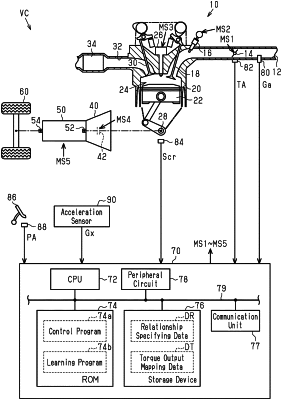| CPC G07C 5/008 (2013.01) [G07C 5/02 (2013.01); G07C 5/0808 (2013.01); G07C 5/0816 (2013.01)] | 15 Claims |

|
1. A vehicle controller used for a first vehicle, the first vehicle being configured to directly perform vehicle-to-vehicle communication with a second vehicle, the vehicle controller, comprising:
processing circuitry, the processing circuitry being configured to execute:
an index deriving process that derives a traveling performance index of the first vehicle, the traveling performance index of the first vehicle being an index related to a traveling performance of the first vehicle,
an index receiving process that receives a traveling performance index of the second vehicle from the second vehicle through the vehicle-to-vehicle communication, the traveling performance index of the second vehicle being an index related to a traveling performance of the second vehicle, and
a performance determination process that compares the traveling performance index of the second vehicle with the traveling performance index of the first vehicle to determine whether a traveling performance of the first vehicle is lower than a traveling performance of the second vehicle; and
a memory configured to store relationship specifying data that specifies a relationship between a state of the first vehicle and an action variable, wherein
the state of the first vehicle affects the traveling performance of the first vehicle indicated by the traveling performance index of the first vehicle,
the action variable is a variable related to operation of an electronic device of the first vehicle,
the electronic device of the first vehicle includes at least one of a throttle valve, a fuel injection valve, an ignition device, a lock-up clutch, a transmission, a power conversion circuit, and an air conditioner,
the processing circuitry is configured to execute:
an obtaining process that obtains a detection value of a sensor configured to detect the state of the first vehicle,
an operating process that operates the electronic device based on a value of the action variable that is determined by the detection value and the relationship specifying data,
a reward calculation process that assigns a greater reward when the detection value indicates that the traveling performance of the first vehicle is higher than a reference performance than when the detection value indicates that the traveling performance of the first vehicle is not higher than the reference performance, and
an updating process that updates the relationship specifying data using the detection value, the value of the action variable used for operation of the electronic device, and a reward corresponding to the operation as inputs to a predetermined update mapping,
the update mapping is configured to output the relationship specifying data that is updated so that an expected return of the reward is increased when the electronic device is operated in accordance with the relationship specifying data, and
the processing circuitry is configured to increase an update speed of the relationship specifying data that specifies the relationship between the state of the first vehicle and the action variable when the performance determination process determines that the traveling performance of the first vehicle is lower than the traveling performance of the second vehicle relative to when the performance determination process determines that the traveling performance of the first vehicle is not lower than the traveling performance of the second vehicle.
|